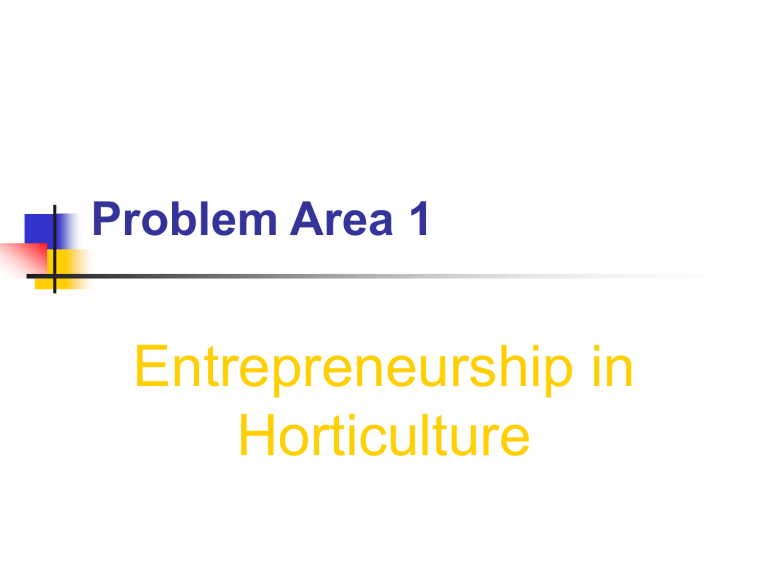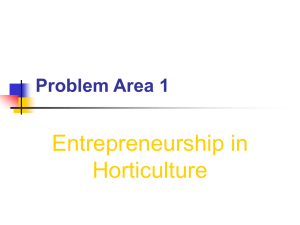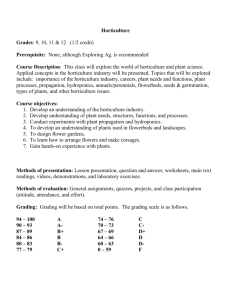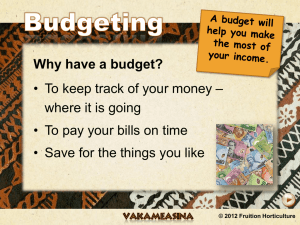PowerPoint

Problem Area 1
Entrepreneurship in
Horticulture
Next Generation Science/Common Core Standards Addressed!
HSNQ.A.1 Use units as a way to understand problems and to guide the solution of multi ‐ step problems; choose and interpret units consistently in formulas; choose and interpret the scale and the origin in graphs and data displays. (HS ‐ LS2 ‐ 4)
CCSS.Math.Content.7.RP.A.3 Use proportional relationships to solve multistep ratio and percent problems. Examples: simple interest, tax, markups and markdowns, gratuities and commissions, fees, percent increase and decrease, percent error.
HSSIC.B.6 Evaluate reports based on data. (HS ‐ LS2 ‐ 6)
Agriculture, Food, and Natural
Resource Standards Addressed
ABS.02.02. Assemble, interpret and analyze financial information and reports to monitor AFNR business performance and support decision-making (e.g., income statements, balance sheets, cash-flow analysis, inventory reports, break-even analysis, return on investment, taxes, etc.).
ABS.02.02.01.a. Compare and contrast the different types of financial reports (e.g., income statements, cash flow statements, equity statements, etc.) and their frequency of use (e.g., daily, weekly, monthly, quarterly, annual) for monitoring AFNR business performance.
Lesson E1-2 Horticulture Core CD 3
Bell Work / Student Learning Objectives
Identify the purposes for financial management.
Define basic financial management principles.
Identify the parts of a financial management plan.
Describe the different types of records kept in horticulture businesses.
Explain how to calculate the cost of products and services.
Terms
Accountant
Assets
Balance sheet
Capital
Cash flow
Cost
Equities
Expense
Fixed costs
Liabilities
Net worth
Overhead costs
More terms
Profit
Profit and loss statement
Revenue
Selling price
Transaction
Variable costs
Lesson 2
Financial Management in the Horticulture
Business
Interest Approach
What if a business didn’t have a business plan?
Would they be able to pay all of their bills?
What would happen if their money ran out before they paid their employees?
How would you feel if your boss didn’t pay you for your work?
What are the purposes of financial management?
For a business to remain profitable, it is important for it to have sound financial management.
Businesses have written financial management plans that make it easier to determine the performance of a business.
There are two common ways for the performance of businesses to be measured.
One way is to compare past and present performance of the same company.
The second is to compare business performance against the performance of other businesses in the same industry.
Business performance can also be measured by comparing the performance of the business to the business’ stated objectives.
What are examples of basic financial management principles?
Running a business requires funds to pay workers, suppliers, and to pay for expenses.
Expense is the cost of producing a product.
An accountant is a person who is responsible for keeping track of expenses, finances, and all business transactions.
A transaction is a business deal or an agreement.
Transactions affect what is called an accounting equation.
In an accounting equation, the sum of liabilities and capital equal assets.
Liabilities are the debts of the business.
A liability is a type of equity.
Equities are the amount something is worth beyond what is owed on it.
In the end, assets should equal equity.
Another form of equity is capital.
Capital is the equity of the business owners.
Assets
Assets are all the elements on the balance sheet that show the resources of the business.
When a business generates revenue , increase in capital due to business transactions, the equation changes.
The result of revenues minus expense is added.
What are the parts of a financial management plan?
There are four main parts of a financial management plan.
Important business decisions will be based on the information presented in the statement within the plan.
The four parts of the plan are
the cash flow analysis
profit and loss statement
balance sheet
the source and use of funds.
Cash flow
Cash flow is the amount of money that goes in and out of a business.
Analyzing this flow will help a business plan and manage debt.
A cash flow statement helps a business determine when it will need to borrow money, how much money it will need to borrow, and when to pay it back.
Profit and loss statement
A profit and loss statement is a summary of a business’s income and expenses for a given period of time.
To utilize a profit and loss statement it is important to compare them to past statements.
In comparing the statements it is important to keep in mind any changes that have occurred that may also affect profits and losses.
Balance shee t
A listing of a business’s assets and liabilities is called a balance shee t.
A balance sheet is a careful breakdown of what a business owns, owes, and its net worth.
Net worth is the difference between a company’s assets and liabilities, or their equity.
A list of a company’s sources and uses of funds is useful in determining how much money a company needs and where these funds come from.
What are the different types of records kept in horticulture businesses?
There are two types of records kept in horticulture businesses, financial records and physical records.
Both types are useful only if kept accurately.
They are also important when reporting taxes to the government.
Financial records
Financial records include the balance sheet, income and expense summary, cash flow statement, and customer credit applications.
Careful financial records can ensure a profitable business.
Physical records
Physical records include production of horticulture crops, inventory records, machinery and equipment records, and labor records.
Careful physical records can help a manager determine what the business has on hand, and when.
How can the cost of products and services be calculated?
Financial and physical records also have another use, calculating costs.
Before a product can be marketed, its price must first be calculated.
Businesses that offer services, such as landscape maintenance or floral design, must also set a price for their services.
The amount of money a customer pays for a product or service is known as the selling price .
This is higher than the actual cost of the product or service.
Cost refers to how much money the business actually spent on producing the product or service sold.
There are two types of costs, fixed and variable.
The expenses involved in running a business are called fixed cost s.
These costs are not directly related to the production of the product or service being sold.
Examples of fixed costs are salaries and maintenance.
Variable costs are costs directly related to the production of a product or service.
These costs have a direct relationship to the amount produced, they are figured on a per unit basis.
Examples of variable costs in a greenhouse would be seeds and planting media.
Service oriented businesses have to take special considerations when determining costs.
The costs involved in providing a service include materials, labor, overhead costs, and profit.
Overhead costs are the fixed costs of running a business.
Profit is the money a business makes from a product or service after deducting the cost involved in producing it.
Review/Summary
What are the purposes of financial management?
What are examples of basic financial management principles?
What are the parts of a financial management plan?
What are the different types of records kept in horticulture businesses?
How can the cost of products and services be calculated?





